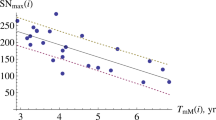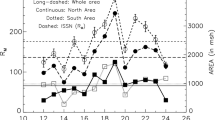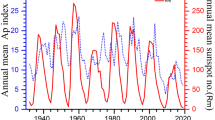Abstract
In this work, we predict the maximum amplitude (using the 13-month smoothed Solar Influences Data Analysis Center (SILSO) Sunspot Number, version 2) of Solar Cycle 25 using as a predictor the slope of the inflection point during the ascending part of the cycle. After a description of the data and methodology employed in this work, we obtain a value of 131 ± 32 for the maximum amplitude of Solar Cycle 25. Finally, we discuss this result in the context of the current debate on the prediction of solar activity and compare it with other predictions of Solar Cycle 25 obtained by other methods.
Similar content being viewed by others
Avoid common mistakes on your manuscript.
1 Introduction
Solar activity is involved in studies of different scientific fields such as solar physics, climate change, and space-mission planning (Haigh, 2007; Hanslmeier, 2007; Usoskin, 2023). Solar activity can potentially affect our society, which is becoming increasingly dependent on technological systems. Some of the problems that can be traced to solar activity are, for example, disruptions of navigation systems, communications, and electric-power distribution grids on the ground. Thus space-weather effects can lead to different social and economic losses (Pulkkinen, 2007). For that reason, the interest in solar-activity behavior and its prediction has been increasing in recent times, not only in the scientific field, but also in society (Overbye, 2021).
Petrovay (2020) classified different types of solar-activity prediction methods. On the one hand, there are methods based on precursors, that is methods that use the statistical relationship between an observed variable and the next maximum of the solar cycle. Obviously, the variable must be available prior to the maximum solar activity. The statistical relationship between the two variables may have an explanation based on our understanding of solar physics, or it may have been found purely statistically. On the other hand, there are prediction methods based on physical models, such as the well-known surface flux-transport models. In addition, we have methods that use extrapolations (see Section 4 of the review by Petrovay, 2020).
Logically, solar physicists prefer to use prediction models created from physical laws. However, the complexity of these models means that other methods continue to be used, even purely statistical ones (which do not contain a physical basis, or, at least, it is not known). However, we must point out the interesting result proposed by Nandy (2021): predictions based on various techniques present a wide variety of results, yet predictions based on physical models are converging for Solar Cycle 25. Therefore it is now more interesting than ever to make predictions with various techniques, including purely statistical, so that intercomparisons can be carried out.
In addition, the prediction of the current Solar Cycle 25 is especially interesting. Whereas different methods used to predict Solar Cycle 25 generally predict an amplitude cycle below the average (Nandy, 2021; Jiang, Zhang, and Petrovay, 2023), some forecasts have predicted an above-average amplitude (Han and Yin, 2019; McIntosh et al., 2020). Note that the forecast made by McIntosh et al. (2020) was recently revised by McIntosh, Leamon, and Egeland (2023) to be a solar cycle with maximum amplitude around the average. In any case, the data observed so far are showing Solar Cycle 25 as a below-average cycle (Carrasco and Vaquero, 2021, 2022).
The objective of this work is to provide a prediction of the maximum amplitude of Solar Cycle 25 from a method that uses the inflection point of the ascending part of the solar cycle, which was first proposed by Lantos (2000). Note that the prediction of Solar Cycle 25 using this method could not be made so far, since the inflection point had not yet occurred during this cycle. In Section 2, we describe the data and methodology employed in this work. The prediction for Solar Cycle 25 obtained from this method is shown and compared with those of other works in Section 3. The main conclusions of this work are discussed in Section 4, including some additional comments and suggestions about this method.
2 Inflection-Point Method and the New Sunspot Number
The inflection-point method (Lantos, 2000) is based on finding a linear relationship between the maximum amplitude of each solar cycle and the slope at the inflection point that occurs in the rising curve to the maximum. The 13-month smoothed sunspot-number series (which uses weights of 0.5 for the first and last value of the running averages) is used as dataset. The inflection point is defined as the point of the ascending part of the solar cycle where the slope is maximum. Note that, following the methodology by Lantos (2000), the slopes are calculated from the 13-month smoothed sunspot-number series. Then, the series of slopes is smoothed through 3-month running averages. The values of those smoothed slopes are the ones referred to, shown, and used for analysis in this work. As an example, for a standard solar cycle, the slope is zero at the solar minimum. Subsequently, the sunspot number and the slope start growing whereas the curve remains concave upward. After a few months, the slope reaches its maximum value (this is the inflection point), and the curve becomes concave downward until it reaches its maximum value of sunspot number (where the slope is zero).
We followed the methodology of Lantos (2000) and reproduced his results using the Solar Influences Data Analysis Center (SILSO) Sunspot Number (version 1). However, version 2 of the Sunspot Number was released in 2015 (Clette et al., 2014; Clette and Lefèvre, 2016), so we have implemented the Lantos (2000) methodology to this latest version and expanded the temporal coverage to the two latest complete solar cycles (Figure 1). Data of the sunspot number are available at the website of the Sunspot Index and Long-term Solar Observations (www.sidc.be/silso).
Relationship between the sunspot number of the solar-cycle maximum and the inflection-point slope for Solar Cycles 9 – 22 (red dots) and 9 – 24 (red dots plus blue diamonds). The red continuous and blue dashed lines represent the best linear fits regarding Solar Cycles 9 – 22 and 9 – 24, respectively.
Considering Solar Cycles 9 – 22, we obtain the following relationship between the maximum value of the 13-month smoothed sunspot number for a solar cycle [SNmax] and the inflection point slope [IPS] of the ascending part of that solar cycle in units of sunspot number per month: SNmax = (14.0 ± 2.8) IPS + (59.4 ± 27.0), \(r = 0.82\), \(p\)-value < 0.001. The estimated standard error for the linear regression is 30.0. If we expand the temporal coverage to include the latest complete cycles (i.e. we consider Solar Cycles 9 – 24), we obtain a new relationship: SNmax = (13.9 ± 2.9) IPS + (58.2 ± 27.1), \(r = 0.79\), \(p\)-value < 0.001 with an estimated standard error equal to 31.9.
Note that the addition of Solar Cycles 23 and 24 reduces the quality of the linear least-squares fit a bit. This is a typical situation for statistical methods and shows how difficult it is to improve them. However, the mentioned addition is far from changing the correlation fit by more than one standard error. All the relevant parameters used in the present study, which we have computed from the 13-month smoothed sunspot-number series, are listed in Table 1.
3 Prediction of the Solar Cycle 25 Amplitude and Discussion
Using the equation of the best linear fit between SNmax and IPS obtained in the previous section (considering Solar Cycles 9 – 24), the prediction for Solar Cycle 25 is 131 ± 32. This is a typical value for a below-average solar cycle (taking into account that the average of existing solar-cycle amplitudes is SNmax = 180).
We compare the prediction obtained in this work with others for Solar Cycle 25 (Figure 2). The forecast obtained in this work is similar to the predicted value by Upton and Hathaway (2023) of 134 ± 8, who revised the maximum amplitude made by the Solar Cycle 25 Prediction Panel of 115 ± 10 (Biesecker and Upton, 2019). Moreover, the inflection-point method provides a maximum amplitude for Solar Cycle 25 (131 ± 32) close to the average of the predictions analyzed by Nandy (2021), which is 136 ± 42.
Representation of the observed 13-month smoothed sunspot number (red line) and the inflection point for Solar Cycle 25 (black dot and vertical line). The prediction of the monthly sunspot number for Solar Cycle 25 (including its upper and lower limits) provided by Upton and Hathaway (2023) [updated May 2023] is depicted in blue (source: solarcyclescience.com/). The prediction made in this work with their error bars is represented by the green dot. Note that to compare results, we considered the same date of the maximum as that by Upton and Hathaway (2023). Vertical dashed lines depict the date of the solar minimum and maximum.
The prediction obtained in the present work using the inflection point is generally consistent with predictions made by model-based methods (Bhowmik and Nandy, 2018; Jiang, Zhang, and Petrovay, 2023). However, the forecast of Solar Cycle 25 made by Labonville, Charbonneau, and Lemerle (2019) based also on a model method predicts a significantly below-average cycle. Predictions made using neural networks and machine-learning techniques are generally similar to our result (Okoh et al., 2018). However, that is not the case for Covas, Peixinho, and Fernandes (2019), who predicted a significantly below-average cycle. Regarding predictions made by authors using precursor methods, we find that the predictions of Solar Cycle 25 range between values significantly below the average solar cycle (Hawkes and Berger, 2018), below the average solar cycle (Petrovay et al., 2018; Pesnell and Schatten, 2018), and around the average cycle (McIntosh, Leamon, and Egeland, 2023). Lastly, there is a wide range of predictions using statistical methods. For example, we found similar prediction to our result (Kakad, Kumar, and Kakad, 2020), but there are forecasts significantly different, such as those by Singh and Bhargawa (2017) and Han and Yin (2019), whose predictions are 103 and 229 for Solar Cycle 25. A comparison of the above predictions for Solar Cycle 25 using different methods is listed in Table 2.
4 Conclusions
In this work, we have updated the method for predicting the maximum amplitude of a solar cycle using the slope of the inflection point during the rising phase of the solar cycle. The update includes the use of the current version 2 of the Sunspot Number and the addition of two more solar cycles. The value obtained for the maximum amplitude of Solar Cycle 25 in terms of the 13-month smoothed sunspot number is 131 ± 32, which corresponds to a below-average cycle. Although this result is significantly different from some predictions (such as Han and Yin, 2019; McIntosh et al., 2020; McIntosh, Leamon, and Egeland, 2023), it agrees with most of the predictions analyzed by Nandy (2021), including the methods based on, for example, physics-based models, precursors, and other statistical methods.
This inflection-point method is based on an empirical linear relationship between the value of the sunspot number at the peak of the cycle and the slope at the inflection point in the rising phase. As with most methods based on empirical relationships, the physical basis of this relationship is unknown, except that it coincides with Waldmeier’s phenomenological rules (Waldmeier, 1935). From our point of view, the prediction of solar activity should be made from models based on known physical laws. However, predictions based on statistics and precursors are interesting since we can compare their results and try to unravel the physical bases that support these phenomenological relationships. In addition, the use of more complex statistical tools, such as Bayesian statistics, could help to improve and correctly interpret this type of predictions, as Arregui (2022) showed.
Data Availability
All data used are publicly available.
References
Arregui, I.: 2022, Methodology for predicting the probability distribution of the amplitude of Solar Cycle 25. Solar Phys. 297, 21. DOI.
Bhowmik, P., Nandy, D.: 2018, Prediction of the strength and timing of sunspot cycle 25 reveal decadal-scale space environmental conditions. Nat. Commun. 9, 5209. DOI.
Biesecker, D.A., Upton, L.: 2019, Solar Cycle 25 consensus prediction update. In: AGU Fall Meeting, Abstract SH13B–03.
Carrasco, V.M.S., Vaquero, J.M.: 2021, Solar Cycle 25 is currently very similar to Solar Cycle 24. Res. Notes Am. Astron. Soc. 5, 181. DOI.
Carrasco, V.M.S., Vaquero, J.M.: 2022, An early assessment of the forecast by the Solar Cycle 25 prediction panel. Res. Notes Am. Astron. Soc. 6, 121. DOI.
Clette, F., Lefèvre, L.: 2016, The new sunspot number: assembling all corrections. Solar Phys. 291, 2629. DOI.
Clette, F., Svalgaard, L., Vaquero, J.M., Cliver, E.W.: 2014, Revisiting the sunspot number. A 400-year perspective on the solar cycle. Space Sci. Rev. 186, 35. DOI.
Covas, E., Peixinho, N., Fernandes, J.: 2019, Neural network forecast of the sunspot butterfly diagram. Solar Phys. 294, 24. DOI.
Haigh, J.D.: 2007, The Sun and the Earth’s climate. Liv. Rev. Solar Phys. 4, 2. DOI.
Han, Y.B., Yin, Z.Q.: 2019, A decline phase modeling for the prediction of Solar Cycle 25. Solar Phys. 294, 107. DOI.
Hanslmeier, A.: 2007, The Sun and Space Weather, 2nd edn., Astrophys. Space Sci. Library 347, Springer, Dordrecht.
Hawkes, G., Berger, M.A.: 2018, Magnetic helicity as a predictor of the solar cycle. Solar Phys. 293, 109. DOI.
Hazra, G., Choudhuri, A.R.: 2019, A new formula for predicting solar cycles. Astrophys. J. 880, 113. DOI.
Jiang, J., Zhang, Z., Petrovay, K.: 2023, Comparison of physics-based prediction models of Solar Cycle 25. J. Atmos. Solar-Terr. Phys. 243, 106018. DOI.
Kakad, B., Kumar, R., Kakad, A.: 2020, Randomness in sunspot number: a clue to predict Solar Cycle 25. Solar Phys. 295, 88. DOI.
Labonville, F., Charbonneau, P., Lemerle, A.: 2019, A dynamo-based forecast of Solar Cycle 25. Solar Phys. 294, 82. DOI.
Lantos, P.: 2000, Prediction of the maximum amplitude of solar cycles using the ascending inflexion point. Solar Phys. 196, 221. DOI.
McIntosh, S.W., Leamon, R.J., Egeland, R.: 2023, Deciphering solar magnetic activity: the (solar) hale cycle terminator of 2021. Front. Astron. Space Sci. 10, 1050523. DOI.
McIntosh, S.W., Chapman, S., Leamon, R.J., Egeland, R., Watkins, N.W.: 2020, Overlapping magnetic activity cycles and the sunspot number: forecasting Sunspot Cycle 25 amplitude. Solar Phys. 295, 163. DOI.
Nandy, D.: 2021, Progress in solar cycle predictions: Sunspot Cycles 24 – 25 in perspective. Solar Phys. 296, 54. DOI.
Okoh, D.I., Seemala, G.K., Rabiu, A.B., Uwamahoro, J., Habarulema, J.B., Aggarwal, M.: 2018, A hybrid regression-neural network (HR-NN) method for forecasting the solar activity. Space Weather 16, 1424. DOI.
Overbye, D.: 2021, Will the next space-weather season be stormy or fair? The New York Times, New York. www.nytimes.com/2021/05/28/science/astronomy-sun-space-weather.html.
Pesnell, W.D., Schatten, K.H.: 2018, An early prediction of the amplitude of Solar Cycle 25. Solar Phys. 293, 112. DOI.
Petrovay, K.: 2020, Solar cycle prediction. Liv. Rev. Solar Phys. 17, 2. DOI.
Petrovay, K., Nagy, M., Gerják, T., Juhász, L.: 2018, Precursors of an upcoming solar cycle at high latitudes from coronal green line data. J. Atmos. Solar-Terr. Phys. 176, 15. DOI.
Pulkkinen, T.: 2007, Space weather: terrestrial perspective. Liv. Rev. Solar Phys. 4, 1. DOI.
Singh, A.K., Bhargawa, A.: 2017, An early prediction of 25th solar cycle using Hurst exponent. Astrophys. Space Sci. 362, 199. DOI. ADS.
Upton, L.A., Hathaway, D.H.: 2023, Solar cycle precursors and the outlook for cycle 25. J. Geophys. Res. - Space, submitted. DOI.
Usoskin, I.G.: 2023, A history of solar activity over millennia. Liv. Rev. Solar Phys. 20, 2. DOI.
Waldmeier, M.: 1935, Neue eigenschaften der sonnenfleckenkurve. Astron. Mitt. 14, 105. ADS.
Acknowledgments
A.J.P. Aparicio thanks Universidad de Extremadura and Ministerio de Universidades of the Spanish Government for the award of a postdoctoral fellowship Margarita Salas para la formación de jóvenes doctores (MS-11). Sunspot data were made available courtesy of the Solar Influences Data Analysis Center (SILSO), Royal Observatory of Belgium.
Funding
Open Access funding provided thanks to the CRUE-CSIC agreement with Springer Nature. This research was supported by the Economy and Infrastructure Counselling of the Junta of Extremadura through project IB20080 (cofinanced by the European Regional Development Fund).
Author information
Authors and Affiliations
Contributions
J.M. Vaquero had the idea of the manuscript. A.J.P. Aparicio made the calculations included in the manuscript. All the authors discussed the results and each one wrote a part of the article. All the authors reviewed the manuscript.
Corresponding author
Ethics declarations
Competing interests
The authors declare no competing interests.
Additional information
Publisher’s Note
Springer Nature remains neutral with regard to jurisdictional claims in published maps and institutional affiliations.
Rights and permissions
Open Access This article is licensed under a Creative Commons Attribution 4.0 International License, which permits use, sharing, adaptation, distribution and reproduction in any medium or format, as long as you give appropriate credit to the original author(s) and the source, provide a link to the Creative Commons licence, and indicate if changes were made. The images or other third party material in this article are included in the article’s Creative Commons licence, unless indicated otherwise in a credit line to the material. If material is not included in the article’s Creative Commons licence and your intended use is not permitted by statutory regulation or exceeds the permitted use, you will need to obtain permission directly from the copyright holder. To view a copy of this licence, visit http://creativecommons.org/licenses/by/4.0/.
About this article
Cite this article
Aparicio, A.J.P., Carrasco, V.M.S. & Vaquero, J.M. Prediction of the Maximum Amplitude of Solar Cycle 25 Using the Ascending Inflection Point. Sol Phys 298, 100 (2023). https://doi.org/10.1007/s11207-023-02194-7
Received:
Accepted:
Published:
DOI: https://doi.org/10.1007/s11207-023-02194-7






